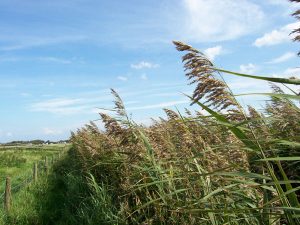The following list is a summary of the work needed to build a horizontal flow gravel reed bed system:
Design the system and procure planning permission. Designs can be drawn up by FH Wetland Systems for use for both planning and construction if needed.
Remove topsoil from the site of the reed bed area.
Mould the subsoil to the specified design for the site. This involves digging out the main basin or cell of the reed bed and building the banks around the system.
Build inlet and outlet manholes. These are usually pre-moulded Wavin fittings at the inlet and plastered concrete block in-situ manholes at the outlet.
Lay the liner material to seal the system. Waterproof bitumen tape is used at the outlet to seal between polyethylene liners and the outlet sewer pipe. A sand blinding and polypropylene geotextile layer may be used to protect the liner both above and below for sites with high percolation. In sites of very poor percolation, no sand should be needed, but prepare the ground well to avoid puncturing the liner.
Backfill with gravel, level to within 3cm. Cover banks and base to the depth specified in the designs, usually 600-700mm.
Fill the system with clean water, then plant with specified wetland plants and seed the surrounding bare soil with grass, grass/clover or native wildflower seed to minimise erosion by rainfall.
Install the septic tank or secondary sewage treatment system, with access points prior to the reed bed for sampling and inspection.
Install percolation area, willow filter or discharge point. This should be completed before the reed bed is used for sewage treatment.
Connect to sewers when plants are established. Only connect after planting is complete. Maintain water levels for at least 12 months after planting to ensure plant health and survival. Note that some designers recommend lowering the water level for two weeks during summer growth to draw down the root system of the plants. Be sure to reset water levels to 50mm below the gravel surface after the fortnight is over.
Follow-up maintenance of the septic tank or secondary treatment system is important to prevent solids carry-over to the gravel reed bed and to maximise treatment efficiency.
See the Permaculture Guide to Reed Beds for plans, materials, checklist and lots more info.

